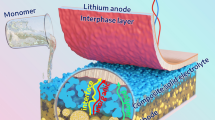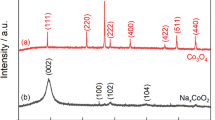Abstract
Two CuC2O4·xH2O-based anode materials with nanoscale microtopography were synthesized by microwave-assisted hydrothermal and solvothermal methods at 120 °C. These two compounds exhibit the higher electrochemical performance compared with other transition metal oxalate-based materials in lithium-ion batteries. The charge-discharge test results reveal that the electrochemical properties of copper oxalate hydrate are significantly better than those of the previous works without assistance of microwave. The quasi-spherical aggregates of CuC2O4·xH2O (x~0.14) possess the initial discharge capacity at 1436 mAh g−1 and the residual capacity at 1260.4 mAh g−1 after 100 cycles at 200 mA g−1. On the other hand, the quasi-cotton aggregates of CuC2O4·xH2O (x~0.49) possess the initial discharge capacity at 1689 mAh g−1 and the residual capacity at 1181.1 mAh g−1 under the same conditions.









Similar content being viewed by others
References
Tarascon J-M, Armand M (2001) Issues and challenges facing rechargeable lithium batteries. Nature 414:359–367
Tarascon J-M (2010) Is lithium the new gold? Nat Chem 2:510
Wang B, Chen JS, Wu HB, Wang ZY, Lou XW (2011) Quasiemulsion-templated formation of alpha-Fe2O3 hollow spheres with enhanced lithium storage properties. J Am Chem Soc 133:17146–17148
Goodenough JB, Kim Y (2010) Challenges for rechargeable Li batteries. Chem Mater 22:587–603
Li H, Wang ZX, Chen LQ, Huang XJ (2009) Research on advanced materials for Li-ion batteries. Adv Mater 21:4593–4607
Wagemaker M, Mulder FM (2011) Properties and promises of nanosized insertion materials for Li-ion batteries. Acc Chem Res 46:1206–1215
Zhou ZR, Dong P, Wang DY, Liu M, Duan JG, Nayaka GP, Wang D, Xu CY, Hua YX, Zhang YJ (2019) Silicon-titanium nanocomposite synthesized via the direct electrolysis of SiO2/TiO2 precursor in molten salt and their performance as the anode material for lithium ion batteries. J Alloys Compd 781:362–370
Zhang XS, Zhou L, Huang MY, Yang CF, Xu YF, Huang JJ (2018) Synthesis of porous Si/C by pyrolyzing toluene as anode in lithium-ion batteries with excellent lithium storage performance. Ionics 1:1–10
Chan CK, Zhang XF, Cui Y (2008) High capacity Li ion battery anodes using Ge nanowires. Nano Lett 8:307–309
Zaghib K, Simoneau M, Armand M, Gauthier M (1999) Electrochemical study of Li4Ti5O12 as negative electrode for Li-ion polymer rechargeable batteries. J Power Sources 81:300–305
Park MS, Wang G, Kang Y, Wexler D, Dou S, Liu H (2007) Preparation and electrochemical properties of SnO2 nanowires for application in lithium-ion batteries. Angew Chem Int Ed 46:750–753
Hu CY, Guo J, Wen J (2012) Hierarchical nanostructure CuO with peach kernel-like morphology as anode material for lithium-ion batteries. Ionics 19:253–258
Reddy MV, Subba GV, Chowdari BV (2013) Metal oxides and oxysalts as anode materials for Li ion batteries. Chem Rev 113:5364–5457
Sun HY, Ahmad M, Zhu J (2013) Morphology-controlled synthesis of Co3O4 porous nanostructures for the application as lithium-ion battery electrode. Electrochim Acta 89:199–205
Ang WA, Cheah YL, Wong CL, Hng HH, Madhavi S (2015) One-pot solvothermal synthesis of Co1−xMnxC2O4 and their application as anode materials for lithium-ion batteries. J Alloys Compd 638:324–333
León B, Pérez CV, Tirado JL (2012) New mixed transition metal oxysalts as negative electrode materials for lithium-ion batteries. Solid State Ionics 225:518–521
López MC, Tirado JL, Pérez VC (2013) Structural and comparative electrochemical study of M(II) oxalates, M = Mn, Fe, Co, Ni, Cu, Zn. J Power Sources 227:65–71
Ang WA, Gupta N, Prasanth R, Madhavi S (2012) High-performing mesoporous iron oxalate anodes for lithium-ion batteries. ACS Appl Mater Interfaces 4:7011–7019
Wu XH, Guo JH, McDonald MJ, Li SG, Xu BB, Yang Y (2015) Synthesis and characterization of urchin-like Mn0.33 Co0.67 C2O4 for Li-ion batteries: role of SEI layers for enhanced electrochemical properties. Electrochim Acta 163:93–101
Xu JM, He L, Liu H, Han T, Wang YJ, Zhang CJ (2015) Controlled synthesis of porous anhydrous cobalt oxalate nanorods with high reversible capacity and excellent cycling stability. Electrochim Acta 170:85–91
Nacimiento F, Alcántara R, Tirado JL (2010) Cobalt and tin oxalates and PAN mixture as a new electrode material for lithium ion batteries. J Electroanal Chem 642:143–149
Zhang Y, Lu Z, Guo M, Bai Z, Tang B (2016) Porous CoC2O4 nanorods as high performance anode material for lithium ion batteries. Nano Lett 68:2952–2957
Oh HJ, Jo CH, Yoon CS, Yashiro H, Kim SJ, Passerini S, Sun Y, Myung ST (2016) Nickel oxalate dihydrate nanorods attached to reduced graphene oxide sheets as a high-capacity anode for rechargeable lithium batteries. NPG Asia Mater 8:270–278
Yeoh JS, Armer CF, Lowe A (2018) Transition metal oxalates as energy storage materials. A review. Mater Today Energy 9:198–222
Aragón MJ, León B, Serrano T, Vicente CP, Tirado JL (2011) Synergistic effects of transition metal substitution in conversion electrodes for lithium-ion batteries. J Mater Chem 21:10102–10107
Aragón MJ, León B, Pérez VC, Tirado JL (2008) Synthesis and electrochemical reaction with lithium of mesoporous iron oxalate nanoribbons. Inorg Chem 47:10366–10371
Aragón MJ, León B, Pérez B, Vicente CP, Tirado JL, Chadwick AV, Berko A (2009) Cobalt oxalate nanoribbons as negative-electrode material for lithium-ion batteries. Chem Mater 21:1834–1840
Ma J, Zhang XD, Chen KZ, Li GC, Han XD (2013) Morphology-controlled synthesis of hematite hierarchical structures and their lithium storage performances. J Mater Chem A 1:5545–5553
Shi SJ, Hua XY, Guo HT (2018) Microwave-assisted one-pot synthesis of SnC2O4/graphene composite anode material for lithium-ion batteries. Ceram Int 44:13495–13501
Holzwarth U, Gibson N (2011) The Scherrer equation versus the “Debye-Scherrer equation.”. Nat Nanotechnol 6:534–534
Behnoudnia F, Dehghani H (2013) Copper(II) oxalate nanospheres and its usage in preparation of Cu(OH)2, Cu2O and CuO nanostructures: synthesis and growth mechanism. Polyhedron 56:102–108
Sun CL, Wu YD, Mei DJ, Doert T (2018) Bi2(IO3)(IO6): first combination of [IO3]− and [IO6]5− anions in three-dimensional framework. Solid State Sci 77:37–43
Ang WA, Cheah YL, Wong CL, Prasanth R, Hng HH, Madhavi S (2013) Mesoporous cobalt oxalate nanostructures as high-performance anode materials for lithium-ion batteries: ex situ electrochemical mechanistic study. J Phys Chem C 117:16316–16325
Kang WP, Shen Q (2013) The shape-controlled synthesis and novel lithium storage mechanism of as-prepared CuC2O4·xH2O nanostructures. J Power Sources 238(2013):203–209
Huang XH, Wang CB, Zhang SY, Zhou F (2011) CuO/C microspheres as anode materials for lithium ion batteries. Electrochim Acta 56:6752–6756
Gong YM, Zhao JC, Wang H, Xu J (2018) CuCo2S4/reduced graphene oxide nanocomposites synthesized by one-step solvothermal method as anode materials for sodium ion batteries. Electrochim Acta 292:895–902
Yang F, Li WY, Tang B (2018) Two-step method to synthesize spinel Co3O4-MnCo2O4 with excellent performance for lithium ion batteries. Chem Eng J 334:2021–2029
Liu BG, Peng JH, Zhang LB, Srinivasakannan C, Huang M, Zhang ZB, Guo SH (2011) Coupling and absorbing behavior of microwave irradiation on the Co(C2O4)·2H2O:Co3O4 system. J Taiwan Inst Chem Eng 42:92–96
Ding HH, Yang JX, Ma SY, Yigit N, Xu JL (2018) Large dimensional CeO2 nanoflakes by microwave-assisting synthesis: lamellar nano-channel and surface oxygen vacancies promoted catalytic activity. ChemCatChem 10:4100–4108
She WC, Luo K, Zhang CY, Wang G, Geng YY, Li L, He B, Gu ZW (2013) The potential of self-assembled, pH-responsive nanoparticles of mPEGylated peptide dendron-doxorubicin conjugates for cancer therapy. Biomaterials 34:1613–1623
Xiang YY, Wang Z, Qiu WJ, Guo ZR, Liu D, Qu DY, Xie ZZ, Tang HL, Li JS (2018) Interfacing soluble polysulfides with a SnO2 functionalized separator: an efficient approach for improving performance of Li-S battery. J Membr Sci 568:380–387
Liu TC, Pell WG, Conway BE, Roberson SL (1998) Behavior of molybdenum nitrides as materials for electrochemical capacitors comparison with ruthenium oxide. J Electrochem Soc 145:1882–1888
Funding
This research is supported by the National Natural Science Foundation of China (nos. 21404068 and 51502169).
Author information
Authors and Affiliations
Corresponding author
Additional information
Publisher’s note
Springer Nature remains neutral with regard to jurisdictional claims in published maps and institutional affiliations.
Electronic supplementary material
ESM 1
(DOC 1565 kb)
Rights and permissions
About this article
Cite this article
Qi, Z., Wu, Y., Li, X. et al. Microwave-assisted synthesis of CuC2O4·xH2O for anode materials in lithium-ion batteries with a high capacity. Ionics 26, 33–42 (2020). https://doi.org/10.1007/s11581-019-03181-4
Received:
Revised:
Accepted:
Published:
Issue Date:
DOI: https://doi.org/10.1007/s11581-019-03181-4




